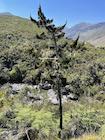Conservation Status

Widdringtonia whytei
Rendle 1894
Common names
Mulanje cedar (Farjon 1998).
Taxonomic notes
Syn.: Callitris whytei (Rendle) Engl. 1895 (Farjon 1998). A molecular study using chloroplast and nuclear ITS sequence data found that W. whytei is sister to a clade containing the remaining species of Widdringtonia (de Roo 2002).
Description
Monoecious evergreen trees to 50 m tall and 150 cm dbh, typically with a single straight trunk and a pyramidal, eventually irregular or flat-topped crown of spreading and ascending branches. Bark soft fibrous, up to 4 cm thick, fissured, brownish gray, exfoliating in long strips. Current-year twigs 7-20 mm long, ± quadrangular, 1-1.5 mm thick. Leaves dull light green, on sterile twigs appressed or some with free apices, ovate to rhombic, 1.5-3.5 × 1-1.5 mm, larger on whip shoots (up to 10 × 4 mm), weakly basally keeled, upper margins minutely denticulate, stomata on both sides in two marginal lines, apex obtuse to acute. Pollen cones oblong, 3-6 × 1.5-2 mm. Seed cones solitary or grouped (not in clusters) on twigs, or terminal on short shoots, maturing in 2 years to subglobos, 15-22 mm diameter cones, serotinous but eventually opening wide. Bract-scale complexes 4, thick-woody, oblong, up to 25 × 15 × 8 mm, slightly incurved, outer surface smooth to rugose, reddish brown to dark brown at maturity. A 1-4 mm long subapical upcurved or recurved boss exposes or encloses the bract apex. Seeds 3-10(-18) per cone, ovoid, flattened, 5-7 × 2-3 mm, very dark, with 2 separate, unequal wings up to 3 mm wide (Farjon 2010). See García Esteban et al. (2004) for a detailed characterization of the wood anatomy.
Distribution and Ecology
S Malawi: endemic to Mt. Mulanje, where it occurs at elevations of 1830-2550 m on rocky, acidic, silicic soils, under a cool tropical montane climate with frequent fog. It is codominant in an Afromontane forest that also includes Podocarpus milanjianus, Cassipourea malosana, Ekebergia capensis, Olea capensis, Polyscias fulva, Rapanea melanophloeos, and Xymalos monospora; also, in the more fire-prone ecotone fringing on grassland, is Widdringtonia nodiflora. It is fire-successional, establishing in the aftermath of fire but, unlike W. nodiflora, regenerating only from seed. Given sufficient time (typically at least 100-200 years) it will give way to dominant angiosperms (Farjon 2010).
The IUCN has assessed this tree as "Critically Endangered." Its native range is very small and, although enclosed within a protected area (the Mulanje Mountain Forest Reserve) and protected from logging, there has been no enforcement of these protections and just within the last decade (as of 2019) it has nearly been extirpated, with no large trees remaining. The species is also threatened by fire, invasive species (including competition with invasive Pinus patula), and non-native pests. Extensive surveys performed in 2017 found fewer than 50 reproductively mature trees. There are conservation nurseries established to propagate seedlings and ca. 500,000 seedlings were outplanted in the 2017-2019 period, but improved protection of both the plants and their habitat will also be needed if the species is to survive (Chanyenga et al. 2019).
Remarkable Specimens
No data as of 2023.03.03.
Ethnobotany
The tree has been heavily exploited for timber. The yellowish-brown is easily worked and decay-resistant, and has been used for construction, general carpentry, paneling and flooring, and furniture-making. There have been attempts at plantation forestry, but substantially higher growth rates are achieved with non-native species, e.g. Hesperocyparis lusitanica. It has never been popular in horticulture, being confined to major botanical gardens and arboreta (Farjon 2010).
Observations
No data as of 2022.12.29.
Remarks
The epithet honors British botanist Alexander Whyte, who explored Mt. Mulanje in 1891.
This is Malawi's national tree.
Citations
Chanyenga, T., K. Shaw, and I. Mitole. 2019. Widdringtonia whytei. The IUCN Red List of Threatened Species 2019: e.T33216A126090798. https://dx.doi.org/10.2305/IUCN.UK.2019-3.RLTS.T33216A126090798.en, accessed on 2022.12.29.
De Roo, Ryan Thomas. 2002. Molecular systematics of the genus Widdringtonia Endl. PhD diss., University of Cape Town, 2002.
Rendle, A. B. 1894. The Plants of Milanji, Nyasa-land, collected by Mr. Alexander Whyte. Transactions of the Linnean Society of London, 2nd series: Botany, 4:60; t. 19. Available: Biodiversity Heritage Library, accessed 2022.12.29.
See also
Global Trees Campaign page on the Widdringtonia whytei nursery and stocking program.
Bayliss, Julian, Steve Makungwa, Joy Hecht, David Nangoma, and Carl Bruessow. 2007. Saving the Island in the Sky: the plight of the Mount Mulanje cedar Widdringtonia whytei in Malawi." Oryx 41(1):64-69. This provides an early look at plans to conserve the species.
Burger, Niel. 2010. Disturbance ecology and size class structure of the Mulanje cedar of Malawi, Widdringtonia whytei and associated broadleaved forest. Bachelor's thesis, University of Cape Town. Provides a more detailed look at the fire ecology of the species.
Pauw, C.A. and H.P. Linder. 1997. Tropical African cedars (Widdringtonia, Cupressaceae): systematics, ecology and conservation status. Botanical Journal of the Linnaean Society 123(4):297-319. This is essentially a monographic treatment of W. nodiflora and W. whytei, and still provides the most comprehensive botanical review.
The species account at Threatened Conifers of the World.
Farjon (2005) provides a detailed account, with illustrations.




